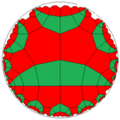Order-6 square tiling
| Order-6 square tiling | |
|---|---|
 Poincaré disk model of the hyperbolic plane | |
| Type | Hyperbolic regular tiling |
| Vertex configuration | 46 |
| Schläfli symbol | {4,6} |
| Wythoff symbol | 6 | 4 2 |
| Coxeter diagram | |
| Symmetry group | [6,4], (*642) |
| Dual | Order-4 hexagonal tiling |
| Properties | Vertex-transitive, edge-transitive, face-transitive |
In geometry, the order-6 square tiling is a regular tiling of the hyperbolic plane. It has Schläfli symbol of {4,6}.
Symmetry
This tiling represents a hyperbolic kaleidoscope of 4 mirrors meeting as edges of a square, with six squares around every vertex. This symmetry by orbifold notation is called (*3333) with 4 order-3 mirror intersections. In Coxeter notation can be represented as [6,4*], removing two of three mirrors (passing through the square center) in the [6,4] symmetry. The *3333 symmetry can be doubled to 663 symmetry by adding a mirror bisecting the fundamental domain.
This bicolored square tiling shows the even/odd reflective fundamental square domains of this symmetry. This bicolored tiling has a wythoff construction t1{(4,4,3)}. A second 6-color symmetry can be constructed from a hexagonal symmetry domain.

|

|
| [4,6,1+] = [(4,4,3)] or (*443) symmetry |
[4,6*] = (*222222) symmetry |
|---|
Example artwork
Around 1956, M.C. Escher explored the concept of representing infinity on a two-dimensional plane. Discussions with Canadian mathematician H.S.M. Coxeter inspired Escher's interest in hyperbolic tessellations, which are regular tilings of the hyperbolic plane. Escher's wood engravings Circle Limit I–IV demonstrate this concept. The last one Circle Limit IV (Heaven and Hell), (1960) tiles repeating angels and devils by (*3333) symmetry on a hyperbolic plane in a Poincaré disk projection.
The artwork seen below has an approximate hyperbolic mirror overlay added to show the square symmetry domains of the order-6 square tiling. If you look closely, you can see one of four angels and devils around each square are drawn as back sides. Without this variation, the art would have a 4-fold gyration point at the center of each square, giving (4*3), [6,4+] symmetry.[1]
Related polyhedra and tiling
This tiling is topologically related as a part of sequence of regular polyhedra and tilings with vertex figure (4n).
| *n42 symmetry mutation of regular tilings: {4,n} | |||||||||||
|---|---|---|---|---|---|---|---|---|---|---|---|
| Spherical | Euclidean | Compact hyperbolic | Paracompact | ||||||||
 {4,3} |
 {4,4} |
 {4,5} |
 {4,6} |
 {4,7} |
 {4,8}... |
 {4,∞} | |||||
This tiling is topologically related as a part of sequence of regular tilings with order-6 vertices with Schläfli symbol {n,6}, and Coxeter diagram ![]()
![]()
![]()
![]()
![]() , progressing to infinity.
, progressing to infinity.
| Regular tilings {n,6} | ||||||||
|---|---|---|---|---|---|---|---|---|
| Spherical | Euclidean | Hyperbolic tilings | ||||||
 {2,6} |
 {3,6} |
 {4,6} |
 {5,6} |
 {6,6} |
 {7,6} |
 {8,6} |
... |  {∞,6} |
| Uniform tetrahexagonal tilings | |||||||||||
|---|---|---|---|---|---|---|---|---|---|---|---|
| Symmetry: [6,4], (*642) (with [6,6] (*662), [(4,3,3)] (*443) , [∞,3,∞] (*3222) index 2 subsymmetries) (And [(∞,3,∞,3)] (*3232) index 4 subsymmetry) | |||||||||||
= = = |
= |
= = = |
= |
= = = |
= |
||||||

|

|

|

|

|

|

| |||||
| {6,4} | t{6,4} | r{6,4} | t{4,6} | {4,6} | rr{6,4} | tr{6,4} | |||||
| Uniform duals | |||||||||||

|

|

|

|

|

|

| |||||
| V64 | V4.12.12 | V(4.6)2 | V6.8.8 | V46 | V4.4.4.6 | V4.8.12 | |||||
| Alternations | |||||||||||
| [1+,6,4] (*443) |
[6+,4] (6*2) |
[6,1+,4] (*3222) |
[6,4+] (4*3) |
[6,4,1+] (*662) |
[(6,4,2+)] (2*32) |
[6,4]+ (642) | |||||
= |
= |
= |
= |
= |
= |
||||||

|

|

|

|

|

|

| |||||
| h{6,4} | s{6,4} | hr{6,4} | s{4,6} | h{4,6} | hrr{6,4} | sr{6,4} | |||||
| Uniform (4,4,3) tilings | ||||||||||
|---|---|---|---|---|---|---|---|---|---|---|
| Symmetry: [(4,4,3)] (*443) | [(4,4,3)]+ (443) |
[(4,4,3+)] (3*22) |
[(4,1+,4,3)] (*3232) | |||||||

|

|

|

|

|

|

|

|

|

|

|
| h{6,4} t0(4,4,3) |
h2{6,4} t0,1(4,4,3) |
{4,6}1/2 t1(4,4,3) |
h2{6,4} t1,2(4,4,3) |
h{6,4} t2(4,4,3) |
r{6,4}1/2 t0,2(4,4,3) |
t{4,6}1/2 t0,1,2(4,4,3) |
s{4,6}1/2 s(4,4,3) |
hr{4,6}1/2 hr(4,3,4) |
h{4,6}1/2 h(4,3,4) |
q{4,6} h1(4,3,4) |
| Uniform duals | ||||||||||

|

|

|

|
|||||||
| V(3.4)4 | V3.8.4.8 | V(4.4)3 | V3.8.4.8 | V(3.4)4 | V4.6.4.6 | V6.8.8 | V3.3.3.4.3.4 | V(4.4.3)2 | V66 | V4.3.4.6.6 |
| Uniform tilings in symmetry *3222 | ||||
|---|---|---|---|---|

|

|

|

| |

|

|

| ||

|

|

| ||
See also
References
- ^ Conway, The Symmetry of Things (2008), p.224, Figure 17.4, Circle Limit IV Archived 2012-07-17 at the Wayback Machine
- John H. Conway, Heidi Burgiel, Chaim Goodman-Strass, The Symmetries of Things 2008, ISBN 978-1-56881-220-5 (Chapter 19, The Hyperbolic Archimedean Tessellations)
- "Chapter 10: Regular honeycombs in hyperbolic space". The Beauty of Geometry: Twelve Essays. Dover Publications. 1999. ISBN 0-486-40919-8. LCCN 99035678.
External links
- Weisstein, Eric W. "Hyperbolic tiling". MathWorld.
- Weisstein, Eric W. "Poincaré hyperbolic disk". MathWorld.
- Hyperbolic and Spherical Tiling Gallery
- KaleidoTile 3: Educational software to create spherical, planar and hyperbolic tilings
- Hyperbolic Planar Tessellations, Don Hatch
- GenusView 0.4 preview View of {4,6} hyperbolic tiling, and matching 3D torus surface.



